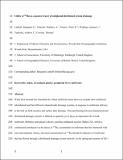Utility of 222Rn as a passive tracer of subglacial distributed system drainage
Abstract
Water flow beneath the Greenland Ice Sheet (GrIS) has been shown to include slow-inefficient (distributed) and fast-efficient (channelized) drainage systems, in response to meltwater delivery to the bed via both moulins and surface lake drainage. This partitioning between channelized and distributed drainage systems is difficult to quantify yet it plays an important role in bulk meltwater chemistry and glacial velocity, and thus subglacial erosion. Radon-222, which is continuously produced via the decay of 226Ra, accumulates in meltwater that has interacted with rock and sediment. Hence, elevated concentrations of 222Rn should be indicative of meltwater that has flowed through a distributed drainage system network. In the spring and summer of 2011 and 2012, we made hourly 222Rn measurements in the proglacial river of a large outlet glacier of the GrIS (Leverett Glacier, SW Greenland). Radon-222 activities were highest in the early melt season (10-15 dpm L-1), decreasing by a factor of 2-5 (3-5 dpm L-1) following the onset of widespread surface melt. Using a 222Rn mass balance model, we estimate that, on average, greater than 90% of the river 222Rn was sourced from distributed system meltwater. The distributed system 222Rn flux varied on diurnal, weekly, and seasonal time scales with highest fluxes generally occurring on the falling limb of the hydrograph and during expansion of the channelized drainage system. Using laboratory based estimates of distributed system 222Rn, the distributed system water flux generally ranged between 1-5% of the total proglacial river discharge for both seasons. This study provides a promising new method for hydrograph separation in glacial watersheds and for estimating the timing and magnitude of distributed system fluxes expelled at ice sheet margins.
Citation
Linhoff , B S , Charette , M A , Nienow , P W , Wadham , J L , Tedstone , A J & Cowton , T 2017 , ' Utility of 222 Rn as a passive tracer of subglacial distributed system drainage ' , Earth and Planetary Science Letters , vol. 462 , pp. 180-188 . https://doi.org/10.1016/j.epsl.2016.12.039
Publication
Earth and Planetary Science Letters
Status
Peer reviewed
ISSN
0012-821XType
Journal article
Description
The authors acknowledge the following funding sources: U.S. National Science Foundation Arctic Natural Sciences Program (ANS-1256669); Woods Hole Oceanographic Institution Arctic Research Initiative, Ocean Ventures Fund, and Ocean Climate Change Institute; United Kingdom Natural Environment Research Council studentship (NE/152830X/1); the Carnegie Trust, Edinburgh University Development Trust. Data presented in this study is archived at: www.aoncadis.org/dataset/GrIS_RADON.html.Collections
Items in the St Andrews Research Repository are protected by copyright, with all rights reserved, unless otherwise indicated.

